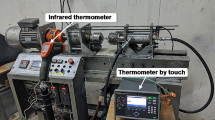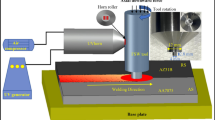Abstract
AA2219 is an age hardenable, high-strength aluminium alloy used for manufacturing propellant tanks in launch vehicles with Friction Stir Welding (FSW). Surface treatment methods such as shot peening, laser shock peening etc., are widely used to improve the fatigue performance of metallic materials and weld joints. This study focuses on the effect of laser shock peening on the tensile properties of AA2219 T87 FSW joint at various temperatures. Specimens were laser shock peened on the crown (top) and root (bottom) sides of the weld joint, and tensile behaviour was studied at room temperature, cryogenic temperature (77 K), and high temperature (423 K). At room temperature, laser shock peening increased yield strength by 7, 10 and 14% with single, three and six layers of peening, respectively. A similar increase (5%—single layer, 7%—three layers, 12%—six layers peening) is observed in cryo temperature also. At 423 K, an increase of 1-7% in yield strength is noticed. However, LSP does not influence ultimate tensile strength and elongation properties significantly. Due to LSP, a high-energy laser pulse impacts the specimen and induces compressive stress on the surface, increasing dislocation density and improving yield strength. Laser shock peening also increased the hardness in all the weld zones. In the Weld nugget region, an increase of 7%, 17% and 20% is observed with single, three and six-layers of peening, respectively, in average microhardness on the crown side of the weld. Irrespective of the number of layers of peening and test temperatures, the failure was found in the thermo-mechanically affected zone due to the dissolution and coarsening of Al2Cu strengthening precipitates.
























Similar content being viewed by others
References
W.J. Muraca, Aluminum Alloy 2219, in Materials Data Handbook (Marshall Space Flight Centre, NASA, 1972).
S.V.S.N. Murty, S.K. Manwatkar, and P.R. Narayanan, Role of Metallographic Analysis in the Identification of Location of Crack Initiation in a Burst Tested AA 2219 Propellant Tank, Metallogr. Microstruct. Anal., 2015, 4(5), p 392-402.
S.V.S. Narayana Murty and S.C. Sharma, Materials for Indian Space Program: An Overview, J. Indian Inst. Sci., 2022, 102(1), p 513-559. https://doi.org/10.1007/s41745-021-00284-8
G.V. Narayana, V.M.J. Sharma, V. Diwakar, K. Sree Kumar, and R.C. Prasad, Fracture Behaviour of Aluminium Alloy 2219–T87 Welded Plates, Sci. Technol. Weld. Join., 2004, 9(2), p 121-130.
B.S. Nair, G. Phanikumar, K. Prasad Rao, and P.P. Sinha, Improvement of Mechanical Properties of Gas Tungsten Arc and Electron Beam Welded AA2219 (Al-6 Wt-%Cu) Alloy, Sci. Technol. Weld. Join., 2007, 12(7), p 579-585.
S. Kou, Welding Metallurgy, 2nd Ed. John Wiley & Sons, Inc., Publication (2003).
R.S. Mishra and Z.Y. Ma, Friction Stir Welding and Processing, Mater. Sci. Eng. R Rep., 2005, 50(1-2), p 1-78.
G. Wang, Y. Zhao and, Y. Hao, Friction Stir Welding of High-Strength Aerospace Aluminum Alloy and Application in Rocket Tank Manufacturing, J. Mater. Sci. Technol., 2018, 34(1), p 73-91.
K.S. Arora, S. Pandey, M. Schaper, and R. Kumar, Microstructure Evolution during Friction Stir Welding of Aluminum Alloy AA2219, J. Mater. Sci. Technol., 2010, 26(8), p 747-753. https://doi.org/10.1016/S1005-0302(10)60118-1
D. Venkateswarlu, M. Cheepu, P.N. Rao, S.S. Kumaran, and N. Srinivasan, Characterization of Microstructure and Mechanical Properties of AA2219-O and T6 Friction Stir Welds, Mater. Sci. Forum, 2019, 969, p 205-210.
J. Kang, Z.-C. Feng, J.-C. Li, G.S. Frankel, G.Q. Wang, and A.P. Wu, Friction Stir Welding of Al Alloy 2219–T8: Part II-Mechanical and Corrosion, Metall. Mater. Trans. A, 2016, 47(9), p 4566-4577.
X. Lei, Y. Deng, Z. Yin, and G. Xu, Tungsten Inert Gas and Friction Stir Welding Characteristics of 4-Mm-Thick 2219–T87 Plates at Room Temperature and -196 °C, J. Mater. Eng. Perform., 2014, 23(6), p 2149-2158.
P.B. Srinivasan, K.S. Arora, W. Dietzel, S. Pandey, and M.K. Schaper, Characterisation of Microstructure, Mechanical Properties and Corrosion Behaviour of an AA2219 Friction Stir Weldment, J. Alloys Compd., 2010, 492(1), p 631-637. https://doi.org/10.1016/j.jallcom.2009.11.198
A.K. Lakshminarayanan, S. Malarvizhi, and V. Balasubramanian, Developing Friction Stir Welding Window for AA2219 Aluminium Alloy, Trans. Nonferrous Met. Soc. China (English Ed.), 2011, 21(11), p 2339-2347.
S. Malarvizhi and V. Balasubramanian, Effect of Welding Processes on AA2219 Aluminium Alloy Joint Properties, Trans. Nonferrous Met. Soc. China, 2011, 21(5), p 962-973. https://doi.org/10.1016/S1003-6326(11)60808-X
S. Malarvizhi and V. Balasubramanian, Influences of Welding Processes and Post-Weld Ageing Treatment on Mechanical and Metallurgical Properties of AA2219 Aluminium Alloy Joints, Weld. World, 2012, 56(9-10), p 105-119.
A.H. Baghdadi, Z. Sajuri, A. Keshtgar, N.M. Sharif, and A. Rajabi, Mechanical Property Improvement in Dissimilar Friction Stir Welded Al5083/Al6061 Joints: Effects of Post-Weld Heat Treatment and Abnormal Grain Growth, Materials (Basel), 2022, 15(1), p 288.
H.-S. Lee, J.-H. Yoon, J.-T. Yoo, and K.-J. Min, A Study on Microstructure of AA2219 Friction Stir Welded Joint in International Symposium on Mechanical Engineering and Material Science (ISMEMS 2016), 2016, p. 6-10.
K.S. Arora, S. Pandey, M. Schaper, and R. Kumar, Effect of Process Parameters on Friction Stir Welding of Aluminum Alloy 2219–T87, Int. J. Adv. Manuf. Technol., 2010, 50(9-12), p 941-952.
S. Rajakumar and V. Balasubramanian, Establishing Relationships between Mechanical Properties of Aluminium Alloys and Optimised Friction Stir Welding Process Parameters, Mater. Des., 2012, 40, p 17-35. https://doi.org/10.1016/j.matdes.2012.02.054
S. Balaji and M.M. Mahapatra, Experimental Study and Modeling of Friction Stir Welding Process to Produce Optimized AA2219 Butt Welds for Aerospace Application, Proc. Inst. Mech. Eng. Part B J. Eng. Manuf., 2013, 227(1), p 132-143.
D. Balaji Naik, C.H. Venkata Rao, K. Srinivasa Rao, G. Madhusudan Reddy, and G. Rambabu, Optimization of Friction Stir Welding Parameters to Improve Corrosion Resistance and Hardness of AA2219 Aluminum Alloy Welds, Mater. Today Proc., 2019, 15, p 76-83. https://doi.org/10.1016/j.matpr.2019.05.027
S. Babu, K. Elangovan, V. Balasubramanian, and M. Balasubramanian, Optimizing Friction Stir Welding Parameters to Maximize Tensile Strength of AA2219 Aluminum Alloy Joints, Met. Mater. Int., 2009, 15(2), p 321-330.
K.K. No, J.T. Yoo, J.H. Yoon, and H.S. Lee, An Experimental Study of Process Parameters on Friction Stir Welded Aluminum Alloy 2219 Joint Properties, Appl. Mech. Mater., 2017, 863, p 3-7.
American Welding Soceity, Specification for Friction Stir Welding of Aluminium Alloys for Aerospace Applications (2009).
MSFC Technical Standard, Process Specification -Welding Aerospace Hardware (2018).
S.W. Williams and A. Steuwer, Residual Stresses in Friction Stir Welding. in Friction Stir Welding: From Basics to Applications (2009).
B. Dhakal and S. Swaroop, Review: Laser Shock Peening as Post Welding Treatment Technique, J. Manuf. Process., 2018, 32, p 721-733. https://doi.org/10.1016/j.jmapro.2018.04.006
L.Y.K. Ding, Laser Shock Peening- Performance and Process Simulation, CRC Press, Woodhead Publishing Limited, England, 2006.
O. Hatamleh, The Effects of Laser Peening and Shot Peening on Mechanical Properties in Friction Stir Welded 7075–T7351 Aluminum, J. Mater. Eng. Perform., 2008, 17(5), p 688-694.
O. Hatamleh, Effects of Peening on Mechanical Properties in Friction Stir Welded 2195 Aluminum Alloy Joints, Mater. Sci. Eng. A, 2008, 492(1-2), p 168-176.
O. Hatamleh, I.V. Rivero, and J. Lyons, Evaluation of Surface Residual Stresses in Friction Stir Welds Due to Laser and Shot Peening, J. Mater. Eng. Perform., 2007, 16(5), p 549-553.
O. Hatamleh, I.V. Rivero, and S.E. Swain, An Investigation of the Residual Stress Characterization and Relaxation in Peened Friction Stir Welded Aluminum-Lithium Alloy Joints, Mater. Des., 2009, 30(9), p 3367-3373. https://doi.org/10.1016/j.matdes.2009.03.038
A. Ali, X. An, C.A. Rodopoulos, M.W. Brown, P. O’Hara, A. Levers, and S. Gardiner, The Effect of Controlled Shot Peening on the Fatigue Behaviour of 2024–T3 Aluminium Friction Stir Welds, Int. J. Fatigue, 2007, 29(8), p 1531-1545.
P. Liu, S. Sun, and J. Hu, Effect of Laser Shock Peening on the Microstructure and Corrosion Resistance in the Surface of Weld Nugget Zone and Heat-Affected Zone of FSW Joints of 7050 Al Alloy, Opt. Laser Technol., 2018, 2019, p 1-7.
P. Liu, S. Sun, S. Xu, Y. Li, and G. Ren, Microstructure and Properties in the Weld Surface of Friction Stir Welded 7050–T7451 Aluminium Alloys by Laser Shock Peening, Vacuum, 2018, 152, p 25-29.
L. Nie, Y. Wu, H. Gong, D. Chen, and X. Guo, Effect of Shot Peening on Redistribution of Residual Stress Field in Friction Stir Welding of 2219 Aluminum Alloy, Materials (Basel), 2020, 13(14), p 1-13.
S. Dixit, A. Mahata, D.R. Mahapatra, S.V. Kailas, and K. Chattopadhyay, Multi-Layer Graphene Reinforced Aluminum – Manufacturing of High Strength Composite by Friction Stir Alloying, Compos. Part B Eng., 2018, 136, p 63-71. https://doi.org/10.1016/j.compositesb.2017.10.028
C.S. Tiwary, J. Prakash, S. Chakraborty, D.R. Mahapatra, and K. Chattopadhyay, Subsurface Deformation Studies of Aluminium during Wear and Its Theoretical Understanding Using Molecular Dynamics, Philos. Mag., 2018, 98(29), p 2680-2700. https://doi.org/10.1080/14786435.2018.1502481
ASTM E8, ASTM E8/E8M Standard Test Methods for Tension Testing of Metallic Materials 1, Annu. B. ASTM Stand. 4, (2010) pp. 1-27.
T. Antony Prabhu, N. Murugesan, S. Ingersol, D.P. Sudhakar, and P.V. Venkitakrishnan, Studies on Notch Tensile Properties of Ti-5Al-2.5Sn ELI at Cryogenic Temperature for Hydrogen Embrittlement Effect, Appl. Mech. Mater., 2018, 877, p 39-43.
G.V. Narayana, Fracture Behaviour of Aluminium Alloy AA 2219-T87 Welded Plates at Room And Cryo Temperatures Supervisors (2006).
P.R. Venkata Narayana, V.M.J. Sharma, V. Diwakar, K. Sreekumar, and M.C. Mittal, Fracture and Damage Mechanisms of Aluminium Alloy 2219-T87 Welded Plates at Room and Cryo Temperatures, in Proceedings of the fourth international conference on fracture and damage mechanics, (Mallorca, Spain, 2005), p. 605-612.
M. Agilan, G. Phanikumar, and D. Sivakumar, Tensile Behaviour and Microstructure Evolution in Friction Stir Welded 2195–2219 Dissimilar Aluminium Alloy Joints, Weld. World, 2022, 66(2), p 227-237. https://doi.org/10.1007/s40194-021-01217-w
M.Q. Ian Polmear, D. StJohn, and J.-F. Nie, Light Alloys-Metallurgy of the Light Metals, 5th Ed. Butterworth-Heinemann (2017).
P.L. Threadgill, A.J. Leonard, H.R. Shercliff, and P.J. Withers, Friction Stir Welding of Aluminium Alloys, Int. Mater. Rev., 2009, 54(2), p 49-93.
Y.C. Chen and K. Nakata, Evaluation of Microstructure and Mechanical Properties in Friction Stir Processed SKD61 Tool Steel, Mater. Charact., 2009, 60(12), p 1471-1475. https://doi.org/10.1016/j.matchar.2009.07.004
P. Manikandan, T.A. Prabhu, S.K. Manwatkar, G.S. Rao, S.V.S.N. Murty, D. Sivakumar, B. Pant, and M. Mohan, Tensile and Fracture Properties of Aluminium Alloy AA2219-T87 Friction Stir Weld Joints for Aerospace Applications, Metall. Mater. Trans. A Phys. Metall. Mater. Sci., 2021, 52(9), p 3759-3776. https://doi.org/10.1007/s11661-021-06337-y
O. Hatamleh, R.S. Mishra, and O. Oliveras, Peening Effects on Mechanical Properties in Friction Stir Welded AA 2195 at Elevated and Cryogenic Temperatures, Mater. Des., 2009, 30(8), p 3165-3173.
S. Mondol, S. Kashyap, S. Kumar, and K. Chattopadhyay, Improvement of High Temperature Strength of 2219 Alloy by Sc and Zr Addition through a Novel Three-Stage Heat Treatment Route, Mater. Sci. Eng. A, 2018, 732, p 157-166. https://doi.org/10.1016/j.msea.2018.07.003
R. Bobbili, V. Madhu, and A.K. Gogia, Tensile Behaviour of Aluminium 7017 Alloy at Various Temperatures and Strain Rates, J. Mater. Res. Technol., 2016, 5(2), p 190-197. https://doi.org/10.1016/j.jmrt.2015.12.002
Acknowledgment
The authors acknowledge the valuable contribution of Dr Duraiselvam, NIT, Trichy, and his team for supporting in carrying out Laser Shock Peening. The invaluable contributions of ISRO colleagues from VSSC (HWMD & MTD), IPRC, and LPSC (MME & LHWC) are sincerely acknowledged.
Author information
Authors and Affiliations
Corresponding author
Ethics declarations
Conflict of interest
The corresponding author states that there is no conflict of interest on behalf of all authors.
Additional information
Publisher's Note
Springer Nature remains neutral with regard to jurisdictional claims in published maps and institutional affiliations.
Rights and permissions
Springer Nature or its licensor (e.g. a society or other partner) holds exclusive rights to this article under a publishing agreement with the author(s) or other rightsholder(s); author self-archiving of the accepted manuscript version of this article is solely governed by the terms of such publishing agreement and applicable law.
About this article
Cite this article
Dhanasekaran, M.P., Agilan, M., Avinash, S. et al. Effect of Laser Shock Peening on AA2219 Friction Stir Weld Joint: Temperature Dependent Tensile Properties. J. of Materi Eng and Perform (2023). https://doi.org/10.1007/s11665-023-09034-6
Received:
Revised:
Accepted:
Published:
DOI: https://doi.org/10.1007/s11665-023-09034-6




